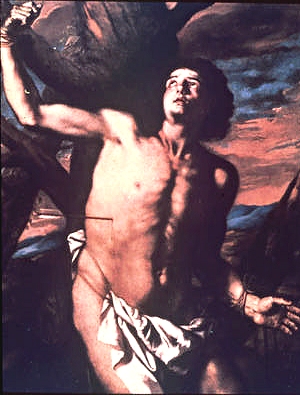 |
|
Saint Sebastian by Niccolo de Simone
Italian, active in Naples 1636 - 1654
SN 144 Oil on canvas signed: Monogram NDS
Bequest of John Ringling 1936
By: Karen Ellsworth
Artist:
There is very little information on Nicolo de Simone. He is not listed in the Dictionary
of Art. His name is spelled differently within the museum. Niccolo is on the label in the
gallery and Nicolo is the spelling in the Peter Tomoroy catalogue. Tomoroy lists him as a
studio assistant to Massimo Stanzione.
In the dictionary of Art under Massimo Stanzione's biography he is not listed among his
students or minor assistants. Tomoroy states that Nicolo de Simone, according to de
Dommenici, traveled extensively after Stanzione's death, working in Spain and Portugal and
finally returning to Naples in his old age.
He was most likely influenced by other artists working in Naples at the time such as
Ribera. St. Sebastian was painted by almost every major painter in the Renaissance period
so there were many models for the painters of Simone's time to have seen. Tomoroy states
that there is an almost identical ST. Sebastian type, only reversed, recently attributed
to an anonymous Neapolitan painter, formerly attributed to Ribera. |
He also mentions that there is a St. Sebastian of the same type painted by Simon
Vouet, c.1622. He further states this might suggest a Caravaggio prototype.
The Suida catalogue attributed this painting to Antonio Zanchi who was one of the leading
Venetian painters of the late 17th Century.
It was attributed to Nicolo de Simone after the monogram NDS was discovered during
conservation in 1963.
History:
Sebastian (third C) was a young nobleman and commander of a company of the Praetorian
Guard, the special bodyguard of the Roman emperors. His secret belief in Christ was
revealed when he encouraged two of his fellow officers, who were being tortured for their
belief, to die rather than renounce their faith. Hearing of this, the Emperor Diocletian
urged Sebastian to abandon his faith in Christ and return to the worship of the Roman
gods. Sebastian refused and was bound to a stake and shot to death with arrows. Sebastian
was left for dead but the mother of one of his martyred friends discovered that he was
still alive and cared for him and advised him to escape from Rome. Sebastian instead came
forth openly and declared his faith anew also pleading for those who had been condemned
and reproaching the emperor for his intolerance. Diocletian was amazed that he was still
alive. Sebastian declared" that God hath delivered from thy hands that I might
testify to the faith of Jesus Christ and plead for His servants" He was then ordered
to be clubbed to death and thrown into the great sewer of Rome. His body was discovered
and was buried in the catacombs at the feet of St. Peter and St. Paul. (Signs and Symbols
in Christian Art)
Sebastian is always shown as a young man whose body is transfixed by arrows. Often he is
bound to a tree or a stake. In ancient times, the plague was believed to have been brought
by Apollo's arrows. Therefore St. Sebastian became one of the chief saints invoked against
that dread disease.
Painting:
This painting hangs over the doorway leading out of Gallery eight. It is an emotional
painting showing St. Sebastian with his eyes looking upward, towards heaven, his arms
outstretched, one arm pointing upwards exposing the area where he was pierced by an arrow.
Simone is showing Sebastian as a handsome youth and as was popular, his ability to depict
anatomy. Although the scene is dramatic the colors are subdued almost dark. Luinis The
Madonna and Child with St.
Sebastian and Roche, shows Sebastian in a relaxed pose, pierced with several arrows,
dripping with blood, but it does not have the immediacy that the Simone painting has. The
colors of Luini are richer. His composition is a sacred conversation and is a more formal
pose. Both figures of Sebastian were strategically draped as was the norm in the late
1600's.
(There are several versions of the rescue of St. Sebastian, one version is that the woman
who cared for him was St. Irene)
I also found a painting of St. Sebastian by Amico Aspertini that is in the National
Gallery with the same gaze towards heaven.
The pose is not as natural as Simones and he is tied to a column which is like many other
Sebastian paintings.
|